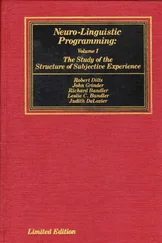It interrupted me, but it didn't interrupt her. She didn't hear it. I knew that because she didn't respond. There was no change in her breathing, her skin color, or her muscle tonus. Since there was no response, it would have been absurd for me to mention it. Woman: If she did hear the tape, how would you have included that in the induction?
"And there are disturbing noises, even at the beach."
Man: What about incorporating the swinging of her leg? I could have. I could put her on a swing at the beach. That would have worked nicely. Utilizing the leg swing and some other pieces of her behavior would have been good choices to make. You don't have to use all the good choices every time that you do an induction, only enough of them to get the response that you want.
Jan: I can remember my leg going around, and at the time I knew why, but I don't now.
How could she recover that information, using the same principles of representational system overlap? … Jan, swing your leg again. Close your eyes and swing your leg again and notice what comes in visually. …A little bit faster.
Jan: Just people's faces.
My interpretation, when I think back about it now, was that she age–regressed as she was doing it—she became a little girl again at the beach. There is a difference between the way an adult swings her leg and the way a child swings her leg. The way she swings her leg now is relatively adult. The way she was doing it when she was in the altered state was more childlike. She was a little girl back at the beach. Do you have any idea how old you were at the beach?
Jan: The same age I am now.
She said she was the same age that she is now, but she also offered me nonverbal facial and tonal changes which are characteristic of age–regression. That's also how I would describe the way she was swinging her leg previously.
OK, any questions about this kind of induction?
Man: I don't remember how you first started. Did you ask her something?
Yes. I did something that I think is extremely useful. I said "Do you like to go to the beach?" and noticed her response. If I had just automatically assumed she liked to go to the beach, I couldn't have known if her entire family had drowned when she was three years old as she stood on the shore watching. In that case, a beach would not have been a good choice for a relaxing induction.
The principle is to discover what representational system a person typically uses in her normal state. Some people utilize all systems, and with them you could actually begin anywhere. In the context of stress—and therapy is one such context—people typically have become specialized. That's part of the way they got stuck and came to you for help. With respect to the presenting problem, they will be specialized in one representational system or another. Simply introducing the other two representational systems will often be adequate for them to come up with some new behavior for themselves. You can do that by using overlap.
Overlap will always be evident in what we do. Not only overlap from one representational system to another, but overlap from the outside to the inside. I know a man who said "I do inductions a hundred different ways." I was interested, so I had him demonstrate as many as he could think of. They were all identical from a formal point of view. On every induction he used the following sequence: outside visual, inside visual, outside kinesthetic, inside kinesthetic, outside auditory, inside auditory. Each of his inductions had different content, but that's the only pattern he used to do inductions. Even though he has only one sequence, he's a very effective hypnotist in terms of achieving the usual outcomes of a traditional hypnotist.
In the context of working here in the group, you could begin with any system unless you have a partner who is already severely specialized. However, I'd like you to take that initial step in order to go through exactly what you would actually do in practice: ask the person something about her previous experience, notice which predicates she uses, and use that system as a place to begin. Offer four or five descriptions in that system, and then find a point of overlap to lead her into another system.
Accessing a Previous Trance State
The easiest of all inductions is to ask your client if she has ever been in a trance before. If she has, you ask her to recount in great detail the sequence of events that occurred the last time she went into a trance. Ask her for the exact configuration of the room, the sound of the hypnotist's voice, and exactly what the hypnotist did to lead her into that profound trance. You will notice that she will relive the experience for you as she describes it. It's an example of automatic regression. In order for her to go back and get all the information in response to the specific questions you are asking, she will re–experience the trance state.
If she rushes over the experience too quickly, and you arc not getting a full response, you can either indicate nonverbally for her to slow down, or ask her questions which require that she give you more detail. You can ask "Were you seated just as you are now?" "No, very differently." "Well, would you show me how?" The body position which she last associated with the altered state of consciousness will help her overlap back to that trance experience.
"Were you in a room like this?" "No, no. The walls were green." "Allow your eyes to close and form a mental image of the room you were in the last time you went… ." You divorce her from her present state, the present space–time coordinates, to give her more freedom to access all the information, and therefore to re–enter the trance state which was most effective for her in the past.
You can add other delivery techniques like embedded commands (sec Appendix II) to your questions to reinforce their power. "Well, was he leaning to his right or to his left when your eyes first began to
close?"
That really is the easiest of all inductions. Usually all you need to do is ask her to recount in detail the sequence of events that occurred when she last went into a deep trance. When she has accessed that trance state, you simply utilize it.
How many people here have ever had the experience of visiting Milton Erickson?
If you look around now, you can tell which of the people here have visited Milton, because as I ask that question, they access the trance experience of being with him.
Naturally Occurring Trance States
There's another really easy way to go after a trance state. Everybody has been in a somnambulistic trance; it's just a question of whether they have recognized it as such.
This morning we asked each of you to pick some state in your personal experience inwhich you have a limited focus of attention. The other two people in your group talked to you about that experience in order to amplify it. You can get the same kind of response without knowing anything about the person by choosing and describing somnambulistic trance states that naturally occur in our culture. What you do is very easy. You sit across from a person and say "Well, before we begin, let's talk about common kinds of experiences, because it is of use tome asa communicator to know what kind of personal history you have, as a way of drawing upon your resources to instruct you in this new matter of hypnosis." Then you describe five very powerful, commonly–occurring trance states. You will notice that as she attempts to understand your words and find examples of what you are talking about in her personal experience, she will go into an altered state.
What happens in your experience when I talk to you about the feelings you have on a long car trip? That's an example of not giving a direct suggestion to go into trance, but simply mentioning a situation where trance states occur naturally in our culture.
Читать дальше











